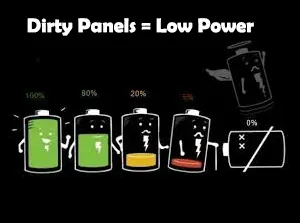
Solar panel systems are a pretty nice addition to households looking to offset their energy bills. But their cost-saving and eco-friendly benefits may also be accompanied by a couple of maintenance duties. Don’t worry, though; unlike your car, these duties rarely extend beyond the occasional wash.
Table of Contents
Why clean your solar panels?
The positioning of solar panels on roofs or in open spaces means they’re usually exposed to everything. So depending on your location, climate, and installation factors, it’s not uncommon to see bird droppings, leaves, pollen, dust, and even grime covering the surface of solar panels.
And as you’ve probably figured out, anything that stops light from passing through isn’t good for your panel’s efficiency. That’s why experts recommend cleaning solar panels at least two times a year.
Dust is the most common culprit when it comes to cleaning panels in the country. But even then, its effect on a panel’s efficiency isn’t as devastating as it may seem at first glance.
Researchers from the University of San Diego found that the average dirty panel loses about 0.05% of its daily production. For a 5 kW system, that’s around a $20 loss on electricity bills over three months.
Another study conducted in Spain measured an average performance drop of only 4.4% after a year’s worth of dust accumulation. Most people won’t notice this drop unless they have a much larger system or the dust accumulates for at least a year.
This explains why homeowners need to clean solar panels; it helps keep your solar system operating at maximum efficiency.
The decision for solar panel cleaning will also depend on:
- How much dust will collect on your solar panels over time? As stated earlier, the average dust buildup does little harm, but it can be a little more devastating in certain situations.
- How big of an impact will dust buildup have on your solar system’s energy production? Experts generally agree that if dust causes your system’s efficiency to drop below 95%, it’s probably time to get cleaning.
- On average, how much rainfall does your local area receive?
Why does rainfall matter?
Solar panels may be exposed to all types of dirt and debris, but they’re also exposed to rainfall, which rinses the dirt away. Studies show that normal rainfall rinses away dust, keeping your solar system operating at around 95% of its maximum capacity. That explains the phrase ‘Let me just leave it to the rain,’ which is usually not bad, but not necessarily the best decision.
You still need to clean your solar panels because dust is often not the only culprit involved. There may also be leaves, pollen, birds dropping, and other debris not so easily washed away by rain. And sometimes, these contaminants only need a little rain to mix into the wrong kind of slurry, making the situation way worse than you need it to be.
The Spanish study also found that long periods without rain can result in daily energy losses as high as 20%. So, in dry climates with lots of dust and wind, solar energy system efficiency drops progressively worse the longer the dry spell lasts.
To make it easier for you to decide if and when to clean your solar panels, here are a few pointers/factors to consider.
The panel’s pitch

A pitched solar panel makes it easier for the rain to clean its surface properly. Experts have discovered that even a pitch as slight as 5 degrees is enough to do the trick. So, if you notice that your solar panels sit completely flat, rainfall may not be achieving the desired effect, and it’s probably time to make cleaning arrangements.
Your location

If your area receives less than a decent amount of rain each year, it’s also good to consider where exactly your system is located. If it sits right next to or downwind to an agricultural field, a busy highway, or factories, it probably receives more dust than the average solar panel system.
Apart from the amount of dust you receive, your location may also influence the type of dirt.
The type of dirt
Next, consider the type of dirt your panels typically receive. Dust and pollen may rinse off easily after rainfall, but industrial smog tends to form a hazy film that’s not easily washed away.
Homesteads surrounded by trees also receive a lot of bird droppings, which may not go away after a little rain. Therefore, regularly inspect your panels before and after it rains to see how much of the dirt is rinsing off. If not, consider having them cleaned before they accumulate too much.
If you decide to clean your panels…
At some point, you’ll decide to clean your solar panels. Maybe it’s because there’s too much dirt buildup, or you just want to keep in line with the one or two-times-a-year recommendation. Either way, you have two options at hand; do the cleaning yourself, or have a professional solar cleaner do it for you.
How do these two compare?
DIY vs. hiring a professional
As a rule of thumb, cleaning your solar panels shouldn’t cost more than whatever savings you may be making from solar energy.

Bluesel home solar estimates that the national average cost for a residential solar cleaning project ranges between $150 and $330. The billing per panel costs anywhere between $15 and $35. This price will vary depending on your location, the size of your solar panel, and how easy it is to access your system.
If you’re more of a cost-minded person, how do you tell if paying to have dirty panels cleaned is worth it? It’s quite simple; compare the cleaning prices with how much your dirty solar panels cost you in daily production losses.
The following formula should help you:
Cost of Monthly Production Loss = (Total kWh Produced by System Each Month) x (30 days x 0.0005) x (Price per kWh)
If the total sum of all monthly losses in a year (or six months)beats the average cost of solar cleaning services in your area, you may consider hiring a professional cleaner.
For some households, the cost of paying over $150 for panel cleaning beats the total cost of having dirty panels. So, they decide to do it themselves DIY style. It may also be that you think cleaning your system is a task you can quite easily handle.
Either way, there are other considerations you need to make before going DIY. These include;
How high is your roof?
Let’s start at safety territory. For the average person, DIY solar cleaning involves spraying water on their solar panels from the ground. This is because dust is quite easy to clean, and spraying upwards with a garden hose replicates the cleaning effect of rain. There is also a safety aspect it; you want to avoid climbing to your rooftop as much as possible.
But if your roof is too high to spray from the ground, some climbing needs to be done. But not necessarily by you; if you’re uncomfortable with ladders and the climb is too high for your liking, it’s best to leave it to the pros.
How are your panels mounted?
Some people are quite comfortable with tall heights and think ladders are just portable stairs- nothing scary about them. If you’re one such person, you may want to consider the arrangement of your panels before climbing.
Are they mounted far enough from the roof’s edges? If you have multiple panels, is there enough space between them? These should help you determine whether you can maneuver around safely as you try to cleaning solar panels.
How’s your roof?
The last of safety concerns is the state of your roof. It may be high enough for you, the spacing quite right for movement, but how’s the pitch, and what are the roofing materials? If the roof is too steep, you should think twice about making the climb. The roof may also be fragile or slippery, and trying to clean your solar panels only puts your life at risk.
What does the dirt buildup look like?

Rain can easily rinse away dust, and so can a little garden hose pressure if applied correctly. However, sticky substances like smoke, bird droppings, and (lots of) pollen are not the most DIY-friendly debris. While it’s still possible to remove them, it can sometimes be a difficult task that involves a lot of scrubbing. If you’re not sure how well you can handle this task, please call your nearest professional solar panel cleaner.
How to clean your solar panels
If you’re confident that the DIY path is safe enough, cleaning your solar panels should be quite easy. Here are a couple of useful tips and how to go about the cleaning process.
Check-in with the solar installer or refer to the user manual
This step will reveal any important information you need to know about the solar system and any special precautions needed before cleaning, like turning off your system.
Try hosing your solar panels off from the ground
Hosing solar panels off from the ground is the easiest, safest, and cheapest way to clean solar panels. It’s most effective if your roof is low and the main problem with your panels is dust accumulation.
Make sure you use enough pressure to rinse away dust, but not too much as it races dirt particles across the panels, which scratch the panel’s surface. These scratches cast tiny shadows on the PV cells, permanently reducing the efficiency of your solar panels.
Also, don’t intentionally spray water on the underside of the solar panel (the space between the panel and your roof). A little accidental splashing won’t do any harm, but too much water at a high enough pressure may cause significant damage to your system.
For heavier buildup that requires you to climb…
You’ll need a soft brush, squeegee, mild soap, and a water hose long enough to reach your panels or a bucket filled with water. These cleaning supplies are readily available in the average home. If you don’t have them, you can always buy all-in-one window washing tools at an affordable price from your local hardware store.

With everything on hand, mix clean water with a small amount of soap. Then rinse the solar panel with clean water to remove any loose dirt. Once in position, use a soft scrubber dipped in soapy water to gently wash the tampered glass of the panel. Next, rinse the washed surface with clean water from the hose and then squeegee the panel dry. Repeat the procedure on all other panels in your system to the best of your satisfaction.
But even as you plan to do this, it’s better to have the necessary safety equipment in place before climbing your roof. The last thing you want is to get injured or, even worse, die while cleaning solar panels.
Also, choosing the right time of day is important when cleaning your panels. During the day, the sun warms the glass to high temperatures. As a result, water evaporates too quickly after coming into contact with the glass, leaving dirty marks that are even harder to clean. The sudden temperature change can also cause the glass to crack, permanently reducing your panel’s energy output.
Therefore, the best times for cleaning are when the temperatures are low, usually on an overcast day, cool evenings, or preferably, early in the morning. The dew that accumulates overnight usually softens stubborn dirt and grime in the morning, reducing the effort, soap, and water required to clean your solar panels.
Or seek professional solar panel cleaning services
Maybe you don’t have enough free time for a little DIY project, lack the appropriate safety equipment, or can’t quite bring yourself to trust a ladder with your weight. Whatever your reasons, don’t hesitate to seek the services of a professional solar cleaner.
Professionals are well trained and equipped for this kind of work and will probably do a much better job than you. Fortunately, many solar panel installers also offer professional cleaning services, sometimes at a discount to their existing clients.

